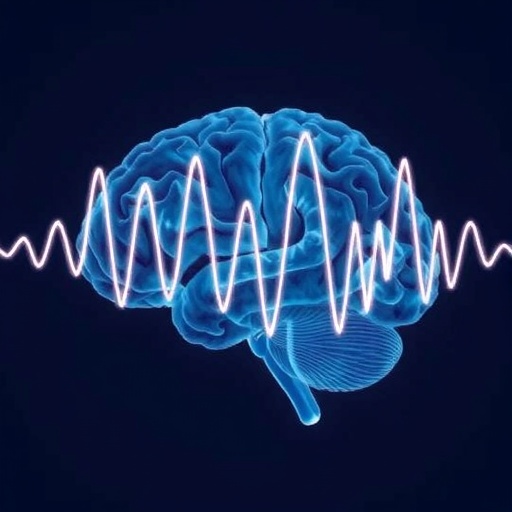In a groundbreaking study poised to deepen our understanding of addiction neuroscience, researchers have uncovered how alcohol-related cues dramatically alter the brain’s electrical signaling networks in individuals with alcohol use disorder (AUD). This task-based EEG investigation reveals specific changes in delta- and theta-band oscillations that reshape the functional connectivity and network topology of brain circuits, ultimately shedding light on the neural substrates that fuel the persistence and relapse of AUD.
Alcohol cues—such as images or environments associated with drinking—are notorious triggers that can provoke relapse in AUD patients. However, the precise ways in which these cues disrupt brain network functions at the electrophysiological level have remained enigmatic. The new research tackles this gap by leveraging a sophisticated EEG-based experimental design combined with advanced graph theoretical analysis, offering unprecedented insights into the brain’s dynamic responses to alcohol stimuli.
Participants underwent a three-stimulus oddball paradigm featuring alcohol-related images designed to evoke cue-reactivity. The study cohort was comprised of 16 individuals diagnosed with AUD and 16 tightly matched healthy controls, ensuring the robustness of observed differences. Following meticulous EEG data quality control, the research team computed source-level phase locking value (PLV) matrices, which quantify synchronous neural oscillations across brain regions, to map functional connectivity patterns during alcohol cue exposure.
One of the most striking findings is a significant reduction in delta-band (1–4 Hz) functional connectivity among AUD patients compared to controls. This diminished connectivity was most pronounced within three major brain networks: the default mode network (DMN), frontoparietal network, and the cingulo-opercular network. These networks are critically involved in self-referential thought, executive control, and sustained attention, respectively, indicating that alcohol-related cues may specifically derail brain systems essential for cognitive regulation and behavioral control in AUD.
Simultaneously, alterations in the theta band (4–8 Hz) revealed an increase in the shortest path length metric within the brain’s functional network topology. An increase in path length typically signals less efficient information transfer between neural assemblies, implying that the exchange of information across the brain is hampered during alcohol cue processing in affected individuals. This is corroborated by observed shifts in nodal centrality—indices reflecting the influence of individual brain regions in the network—with notable decreases in the right prefrontal cortex, left posterior insula, and left basal ganglia.
Conversely, areas such as the left parietal cortex, bilateral occipital lobes, and right mid-insula exhibited heightened centrality during cue exposure. This reorganization points to a compensatory or maladaptive redistribution of neural processing responsibilities in response to alcohol-related stimuli, highlighting the complexity of pathological brain network remodeling in addiction.
What deepens the clinical relevance of these findings is the documented correlation between centrality measures in specific brain regions and patients’ drinking behaviors and clinical assessment scores. Such associations suggest that the network disruptions observed are not merely epiphenomena but are closely tied to the severity of AUD symptomatology and possibly relapse risk, providing a potential biomarker landscape for therapeutic targeting.
The study’s approach marks a technical advance in addiction research, integrating source-level EEG PLV construction with graph-theoretical metrics, thereby moving beyond traditional linear analyses to capture the rich topology of neural information flow. This methodological rigor allows for a refined characterization of how brain networks orchestrate pathologic cue processing, opening avenues for interventions that might restore functional connectivity integrity.
The implications of these results extend far beyond academic interest, signaling potential pathways for developing novel neuromodulation therapies. Techniques such as transcranial magnetic stimulation (TMS) or neurofeedback targeting oscillatory dynamics in the delta and theta bands might one day help recalibrate dysfunctional networks, reducing cue-reactivity and preventing relapse.
This work also highlights the importance of considering frequency-specific brain activity when evaluating neural impairments in psychiatric disorders. The dichotomous roles of delta and theta bands in network integration and information transfer efficiency uncovered here underscore the nuanced interactions between oscillatory activity and addictive behaviors.
Importantly, the research adhered to stringent experimental standards and was registered in the Chinese Clinical Trial Registry (ChiCTR2300076251), ensuring transparency and replicability. Recruitment began in late 2023, reflecting the study’s freshness and the cutting-edge nature of the techniques employed.
In sum, the investigation elucidates the neural signatures of alcohol cue processing in AUD, emphasizing disrupted delta-band network integration and compromised theta-band network efficiency as key contributors to pathological cue-reactivity. These insights herald a new chapter in understanding the brain’s complex network alterations in addiction and pave the way for targeted, brain-based interventions.
As substance use disorders continue to present a global health challenge, studies like this provide critical mechanistic insights needed to design precision treatments aimed at the brain’s dysfunctional networks. The intricate web of altered connectivity identified here may serve as a roadmap for both diagnostic biomarkers and therapeutic innovation, ultimately improving outcomes for individuals battling alcohol use disorder.
Subject of Research: Neural mechanisms of alcohol cue processing in alcohol use disorder (AUD) via EEG functional connectivity and network topology analysis.
Article Title: Alcohol cue processing alters delta-band functional connectivity and theta-band network topology in alcohol use disorder: a task-based EEG study
Article References:
Wang, S., Zhang, J., Shao, Z. et al. Alcohol cue processing alters delta-band functional connectivity and theta-band network topology in alcohol use disorder: a task-based EEG study. BMC Psychiatry (2025). https://doi.org/10.1186/s12888-025-07629-y
Image Credits: AI Generated




